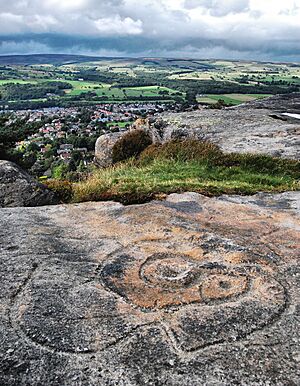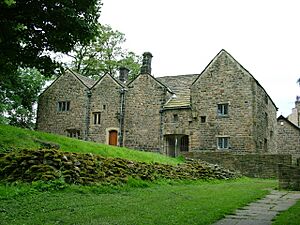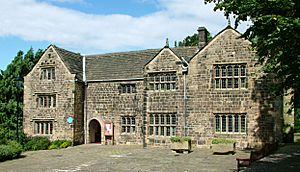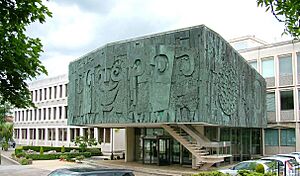History of Ilkley facts for kids
Ilkley is a lovely town in West Yorkshire, England. People have lived here for a very long time, even since the Mesolithic period (that's about 11,000 years ago!). It was once home to a Roman fort and later became a famous spa town. Today, many people live in Ilkley and travel to nearby cities like Bradford, Leeds, and Keighley for work.
The name 'Ilkley' has changed over time. Old names like Hillicleg (around 972 AD) and Illiclei (in the Domesday Book) might mean 'a woodland clearing belonging to a person named Yllica or Illica'.
Contents
Ancient Times in Ilkley
The very first signs of people living in the Ilkley area are flint arrowheads. These tiny tools date back to the Mesolithic period, which began about 11,000 years ago. You can see some of these arrowheads and learn more about ancient Ilkley at the Heritage Room in Ilkley Manor House.
Life in the Bronze Age
People have lived around Ilkley continuously since at least the early Bronze Age, which started around 1800 BC. More than 250 cup and ring marks have been found carved into rocks. These are mysterious patterns, like circles and hollows. A curved swastika carving from this time has also been found.
Archaeologists have discovered remains of ancient homes on Ilkley Moor. A druidical stone circle, called the Twelve Apostles Stone Circle, was built 2,000 years ago. People became very interested in Ilkley's rock art after a book about it was published in 1879.
Ilkley and the Brigantes Tribe
Ilkley was once in the middle of the land belonging to the Brigantes, a powerful ancient British tribe. It was one of their ten strongholds. The town was also on an old track-way that existed before the Romans arrived. This path ran from the north, through places like Catterick, all the way to Chester and Holyhead.
Roman Ilkley
For a long time, people thought Ilkley was the Roman place called Olicana. However, a special stone called the 'Verbeia Stone' changed this idea. Now, Roman Ilkley is usually called 'Verbeia'. Olicana is now thought to be a different place called Olenacvm, near Skipton.
Roman Roads and the Fort
During the Roman period, Ilkley was an important crossroads. Roman roads connected it to other places like Catterick, Adel, Skipton, and Manchester.
The remains of a Roman fort are still visible near the center of town. This fort was built, destroyed, and rebuilt several times. The first fort was made of wood around 80 AD, then left empty around 100 AD. It was used again in 169 AD, burned down around 196–197 AD, and then rebuilt with stone before 198 AD. The fort was last rebuilt and reorganized around 300 AD.
The fort was quite small, about 2.75 acres. It sat on a steep bank above the River Wharfe, with the river on its north side. Two small streams bordered its east and west sides. You can still clearly see the fort's foundations on the bank. Pieces of Roman brick, glass, and pottery have been found there. The medieval Ilkley Manor House and All Saints Parish Church are now located inside what used to be the fort.
Roman Discoveries
Many Roman altars, carvings, and monuments have been found in Ilkley. The most famous is the 'Verbeia Stone'. This stone altar has a message carved into it that says: "Sacred to Verbeia: Clodius Fronto, prefect of the Second Cohort of Lingonians (set this up)". Verbeia was the Roman-British goddess of the River Wharfe. Her name might even be related to the river's name!
A statue found near the altar might have been Verbeia herself. This figure has unique features, a pleated robe, and holds a snake in each hand. It's possible that Verbeia is the same goddess as Boand, an ancient Irish goddess of the Boyne River. A copy of the Verbeia Stone, made in 1608, is kept with the original in the Heritage Room at Ilkley Manor House.
Another interesting find is a sandstone tombstone from the 1st or 2nd century. This is the only Roman carving in Ilkley that talks about everyday civilian life. The tombstone shows a woman wearing a tunic, sitting in a rounded chair. She has long braided hair, which she holds in her hands. The carving says: "To the spirits of the departed: Ved[.]ic[..], daughter of …, aged 30, a tribeswoman of the Cornovii, lies here". This tombstone is also kept in Ilkley Manor House.
Anglo-Saxon Period
Not much is known about Ilkley for 800 years after the Roman fort was improved. However, by the time of the Normans, the area had an Anglo-Saxon name. It was a parish with a church and a priest. There were four main centers of life: Ilkley, Nessfield, Middleton, and Stubham.
Ilkley's location on old roads and paths meant it was affected by different groups invading Britain during the Dark Ages. Angles, Saxons, and Danes all settled here. They gave names to local places and likely mixed with the people already living there.
The Anglo-Saxon church in Ilkley is thought to have been consecrated (made holy) in 627 AD. This might have happened after Paulinus preached there. Three beautiful Anglo-Saxon crosses, which used to be in the churchyard, are now inside the church to protect them from damage. They date back to the 8th century.
Norman Times and the Middleton Family
Ilkley was part of a larger area called the Wapentake of Skyrack. The land north of the river was in the wapentake of Claro. In the Domesday Book of 1086, Ilkley was owned by William de Percy.
By 1242, the land belonged to the Kyme family. Philip de Kyme appointed the first priest for the parish church on December 11th. Later, the Middelton family of Myddelton Lodge bought the land. They owned it for about 100 years after William the Conqueror.
The Middleton family lost their land through sales and mortgages starting in the early 1800s. However, the people working for William Middelton (who lived from 1815 to 1885) were responsible for designing the new town of Ilkley. This new town replaced the small village that was there before.
Ilkley as a Spa Town
In the 1600s and 1700s, Ilkley became known for its special water. People believed the water had healing powers. The Middleton family built White Wells, an early spa building with changing rooms and a bath fed by a spring. They also encouraged visitors by allowing hunting and fishing. Before it became a spa town, Ilkley was just a "little, old and ragged village" with small, thatched cottages.
The Hydropathic Movement
In the 1800s, Ilkley became a very popular spa town. A huge building called the Ben Rhydding Hydro was built between 1843 and 1844. Tourists came here to 'take the waters' and bathe in the cold spring water. The area where the Hydro was built is now called Ben Rhydding, named after the Hydro itself.
The town grew even faster when a railway line from Leeds and Bradford opened in 1865. This made it much easier for visitors to reach Ilkley. Charles Darwin, the famous scientist, even came to Wells House for water treatment in 1859, when his book On the Origin of Species was published. Other famous Victorian visitors included Madame Tussaud. Today, the only remaining spa building is the white cottage known as White Wells House. You can still visit it on the edge of the moor, looking over the town.
Ilkley in the 20th Century
In the early 1900s, a large and grand house called Heathcote was built in Ilkley. It was designed by a famous architect, Edwin Lutyens, for a wool merchant. It's now a very important historic building.
In 1916, the famous writer T. S. Eliot gave several talks in Ilkley about modern French literature.
Rudolf Steiner's Lectures
From August 5th to 17th, 1923, the philosopher and educator Rudolf Steiner gave fourteen lectures in Ilkley. These talks were later published as A Modern Art of Education and explained his ideas for Waldorf education. Steiner talked about Ilkley's ancient history, saying:
"In the remains of ancient altars lying around everywhere, [Ilkley] has traces of something that reminds one of the ancient spirituality. It is very moving to see the modern industrial world and then climb a hill in this region and find the remains of ancient altars."
Jimi Hendrix's Visit
In 1967, the legendary musician Jimi Hendrix played a concert at the Troutbeck Hotel in Ilkley. However, the show was stopped early by the police! The local newspaper headline read "Pop Fans Ran Amok in Hotel". This was because audience members reportedly damaged doors, pulled out electrical fittings, and smashed furniture after a police officer stopped Hendrix in the middle of a song.
Ilkley Literature Festival
The annual Ilkley Literature Festival began in 1973. It is now the largest literature festival in Northern England. The famous poet W. H. Auden gave his very last reading in England at this festival in the same year.
The Ilkley Moor UFO Incident
There was an alleged UFO incident on Ilkley Moor on December 1st, 1987. A retired police officer claimed that he was taken by aliens while on a morning walk. He said he was briefly held on their craft before being returned to the moor. The man even took a photograph of the moor, which he said showed one of the aliens that took him!







